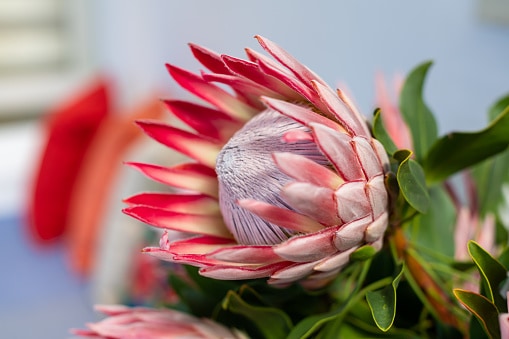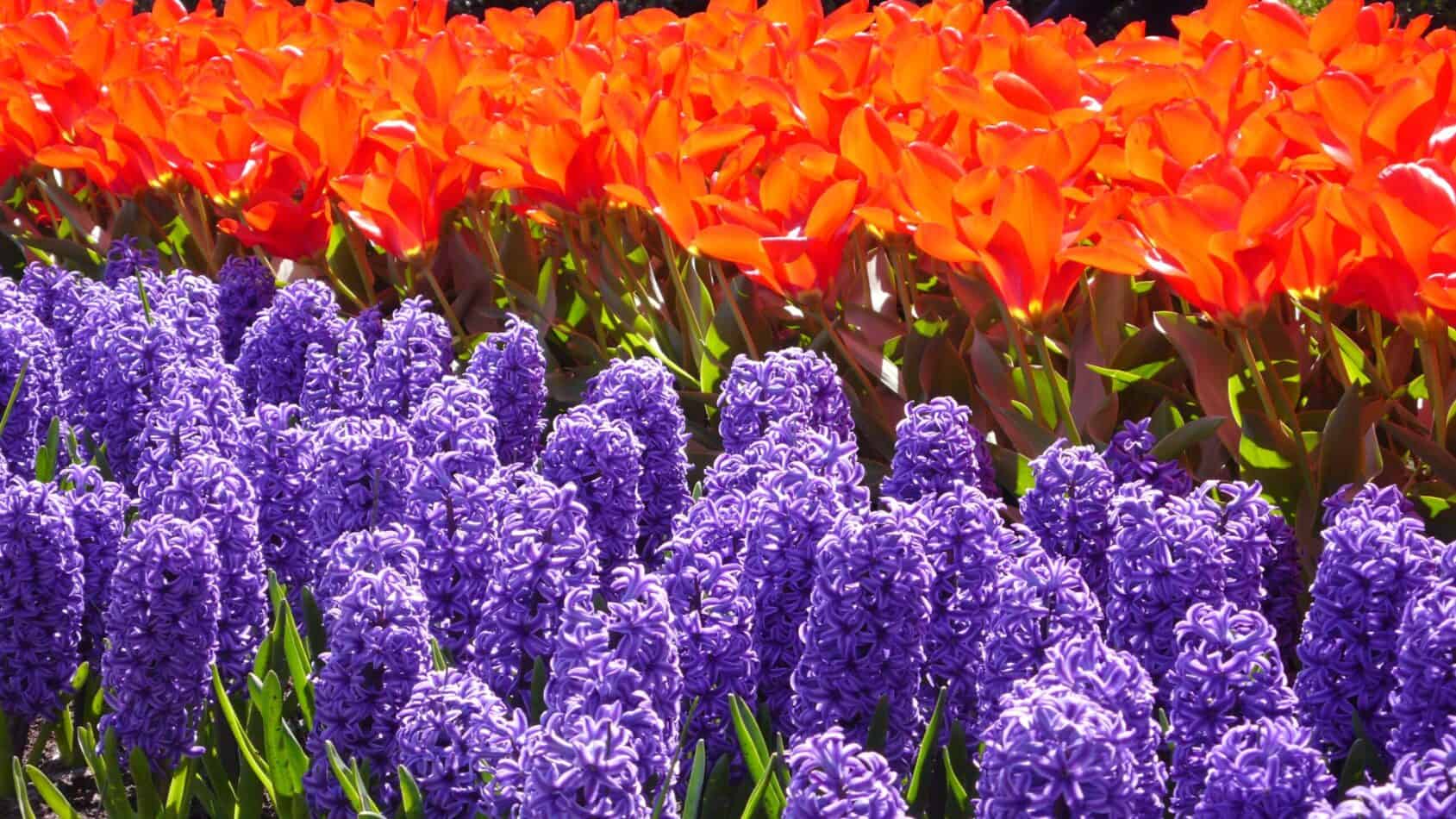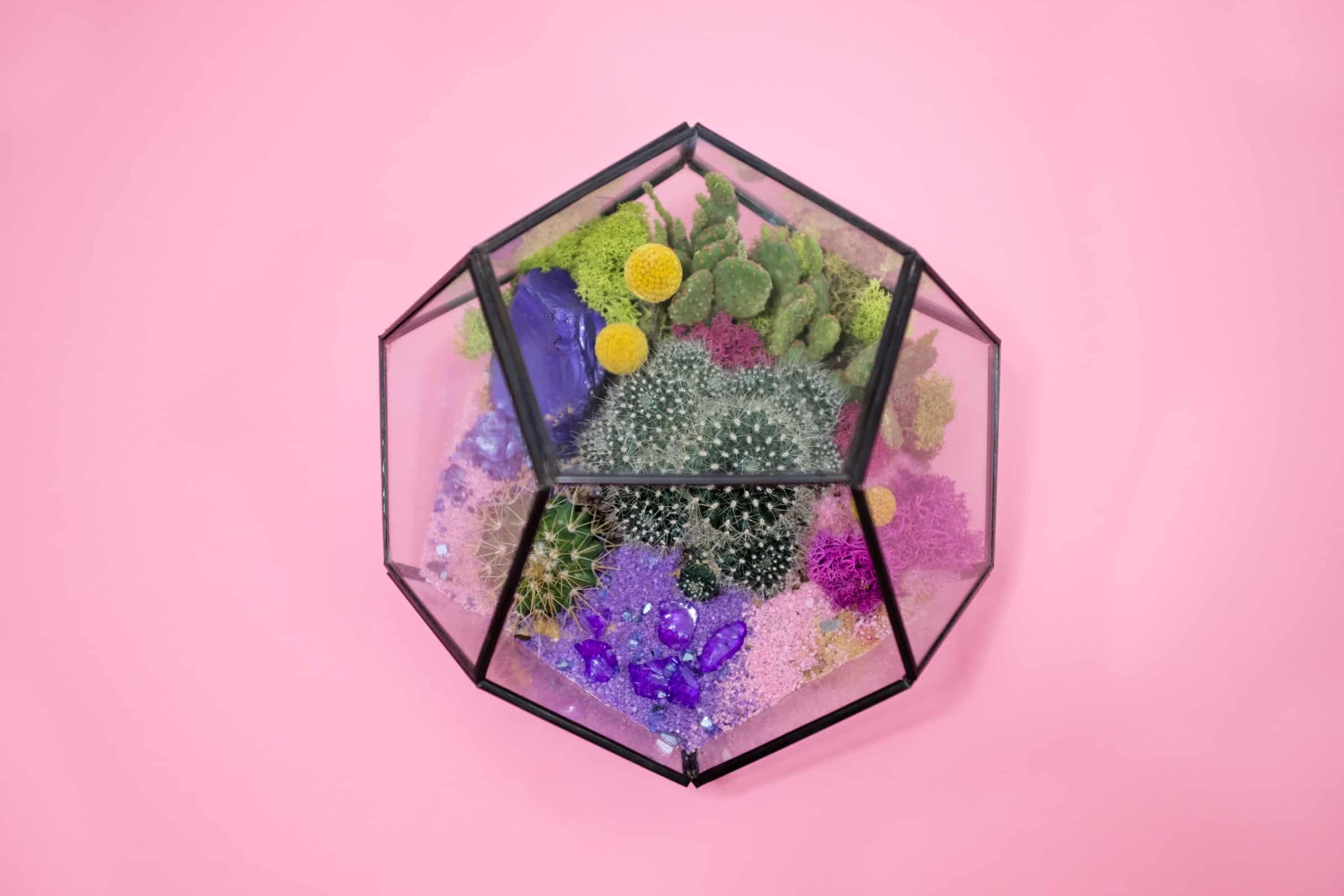The King Protea, also known as Protea cynaroides, is instantly recognisable with its unique shape and structure. It is the national flower of South Africa, and despite its delicate appearance is an evergreen shrub renowned for its large flower heads. Each head consists of a central bouquet of small inner flowers, surrounded by captivatingly vibrant bracts. On average, they produce between six and ten flower heads per plant. For healthy flowering, the King Protea benefits from full sun exposure in both indoor and outdoor environments.
Etymology
The King Protea, Protea cynaroides, is native to South Africa, and is part of the Proteaceae family which includes other flowers such as Banksia and is named after the Greek god Proteus. Its species name cynaroides is derived from the Greek word “Kynaram” meaning artichoke due to its similarity in appearance to the vegetable. The cape artichoke flower is another common name for the King Protea due to their striking resemblance.
Meaning and Symbology
The King Protea symbolizes strength, courage, and transformation, making it a popular flower for weddings, anniversaries and other special occasions. In South African culture, it is seen as a representation of rebirth due to its resilience to survive in harsh, dry climates. Additionally, its petals also act as a simplification of the beauty and structure of a human eye. When given as a gift, the King Protea serves as an ode to someone to whom you wish a long and happy life.
History, Mythology and Religious Significance
In early Greek mythology, Proteus was the first personification of time, of eternity and history. He was known to transform from beast to beast and from shape to shape, and due to the resilient nature of this flower, it was later named after him. In South Africa, the King Protea has been recognised as the National Flower since 1976 along with the South African flag and national anthem. For many, its delicate petals reflect the beauty of mosaic when combined with the country’s diverse population.
Flower Varieties and Their Defining Characteristics
King Protea flowers come in several varieties, such as Protea cynaroides, Protea eximia, Protea compacta and Protea cordata. Each variety has unique characteristics; for example, the Protea cynaroides has large, spiky blooms with bracts in shades of pink, purple and white. The Protea eximia is a smaller version of the cynaroides variety and produces white and pink bracts. The Protea compacta is slightly larger than the eximia and produces large red, yellow and white flowers with reddish bracts. Finally, the Protea cordata has small, rounded blooms, consisting of shades of pink, yellow and white bracts, that grow in clusters on sturdy stems.
How to Plant
The King Protea is perfectly suited to both indoor and outdoor environments, but it prefers direct sun to thrive and flower. When planting, a well-draining soil is essential (a mix of sand and peat moss is optimal) and the soil should be moderately acidic (between 6.0 and 6.5). Before planting, it is beneficial to soak the rhizome to promote root growth. On average, plants can expect to reach 1.5 metres in height, with most flowering when the plant is two to three years old.
It is important to give the King Protea plenty of water. During dry periods, it should be watered at least two to three times a week during the spring and summer months and reduced during the winter. If grown in a pot, fertiliser can be supplied during the autumn and spring months when this flower requires the most food.— and use slow releasing fertilisers for long-term nutrition.
How to Pot and Repot
The King Protea is often planted in combination with other plants to create captivating displays. To create your own, prepare a well-draining soil in either a wooden container or a terracotta pot. For best results look for a potting mix that contains small amounts of grit or perlite to help drainage and provide air pockets between particles. When planting, a layer of stones or other heavy particles should be added at the bottom of the pot to improve drainage and keep the roots from becoming waterlogged.
When potting it is important to leave at least 3 inches (7.6 cm) of space between the root of the plant and the edge of the pot. The King Protea is an evergreen, so will require repotting every couple of years to maintain healthy roots and blooms. Transplanting should be done in the spring when the flowers are no longer in full bloom.
How to Prune
To ensure your King Protea continues to flourish, it’s important to properly prune the plant. Pruning is best done during the winter months when the flower is dormant. To begin, the old flower heads need to be removed to promote new blooms. As new growth appears, the stems should be trimmed to a desired length. The location of the King Protea is also important, as exposure to direct sunlight will give the best results for regrowth and blooming, while too much shade can inhibit growth.
How to Propagate
Propagation of the King Protea is best done by taking cuttings from the stems of your plants. Remove a healthy stem cutting including at least two to three leaves and dip the end in a rooting hormone. Plant the cuttings in a well-draining potting mix and water once a week, providing bright, indirect sunlight. The cutting should be kept in a warm, humid environment and after a few months, new growth should appear at the cutting indicating successful propagation.
Common Pests and Diseases
The most common problem when caring for the King Protea is with pests such as aphids, mites and sawflies. In most cases, the damage will be discovered on the young leaves and buds. To reduce the spread of pests and diseases, use insecticidal soap and keep the leaves dry by improving air circulation. If there are any signs of wilting or discoloration, remove and dispose of the infected plants as soon as possible to protect the others.
Three Frequently Asked Questions about Protea Cynaroides
Q. What sort of sunlight does the King Protea need?
A.The King Protea prefers full sun and does best when placed in an East-facing window or an outdoor area with direct sunlight for a few hours per day.
Q. How often does the King Protea need to be fertilised?
A.The King Protea should be fertilised every 3 months using a slow-release fertiliser. During the blooming season, the flower should be fertilised more often and provided with more water.
Q. How much space should be left between King Protea plants?
A.When planting multiple King Protea in the same area, it is best to leave 20 to 25 cm of space between plants in order to allow adequate airflow. This will help minimise the risk of diseases, pests, and fungal growth.
Table Fact Sheet with Data
| King Protea | Protea cynaroides |
|---|---|
| Family | Proteaceae |
| Plant Type | Evergreen shrub |
| Mature Size | 1.5 metres |
| Sun Exposure | Full sun |
| Soil Type | Well-draining, sandy soil |
| Soil pH | Moderately acidic (6-6.5) |
| Bloom Time | Spring-autumn |
| Flower Color | Pink, purple, white, red and yellow |
| Hardiness Zones | 9-10 |
| Native Area | South Africa |
What we love from Amazon this week
Buy these wonderful flowers directly from Amazon:















